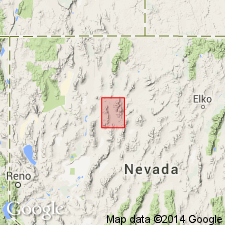
- Usage in publication:
-
- Augusta Mountain formation*
- Modifications:
-
- Areal extent
- AAPG geologic province:
-
- Great Basin province
Summary:
Augusta Mountain formation is geographically extended to Winnemucca 30' quad, Humboldt and Pershing Co., NV. Consists of limestone and dolomite with some shale. Thickness about 200 ft increasing southward to 2500 ft in the Mount Tobin 30' quad. Overlies the Panther Canyon formation (new). Age is late Middle Triassic (Ladinian) based on fossils [pelecypods, gastropods].
Source: GNU records (USGS DDS-6; Menlo GNULEX).
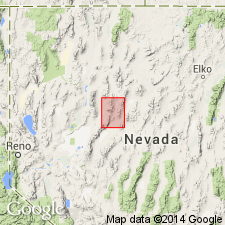
- Usage in publication:
-
- Augusta Mountain formation*
- Modifications:
-
- Original reference
- Dominant lithology:
-
- Limestone
- Dolomite
- AAPG geologic province:
-
- Great Basin province
Summary:
Augusta Mountain formation. Limestone and dolomite with some intercalated shale. At type locality subdivided into three unnamed members. Total thickness about 2500 feet. Conformably underlies Cane Spring formation (new); conformably overlies Favret formation (new). Age is Middle Triassic.
Type locality: exposures underlying west, north, and east flanks of Lone Peak [now Cain Mountain], in T. 25 N., R. 39 and 40 E., Augusta Mountain [now Augusta Mountains], Lander Co. [now in extreme southeastern Pershing Co.; see Cain Mountain 15-min quadrangle], northwestern NV.
Source: US geologic names lexicon (USGS Bull. 1200, p. 171); supplemental information from GNU records (USGS DDS-6; Menlo GNULEX).
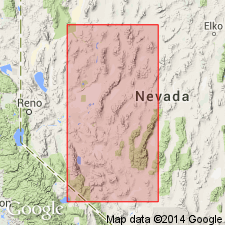
- Usage in publication:
-
- Augusta Mountain Formation*
- Modifications:
-
- Age modified
- Biostratigraphic dating
- AAPG geologic province:
-
- Great Basin province
Summary:
Age of the Augusta Mountain Formation is Middle and Late Triassic (Ladinian and early Karnian [TRACHYCERAS Zone]) based on fossils [ammonites]. Overlies the Favert and Panther Canyon Formations. Underlies the Cane Spring Formation. Is included in "Augusta sequence" in Augusta Mountain where six formations (Tobin, Dixie Valley, Favert, Augusta Mountain, Cane Spring, and Osobb) form unbroken succession of late Early Triassic to middle Late Triassic age.
Source: GNU records (USGS DDS-6; Menlo GNULEX).
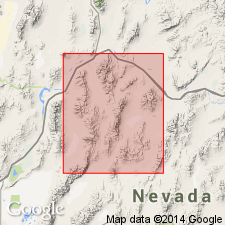
- Usage in publication:
-
- Augusta Mountain Formation*
- Modifications:
-
- Revised
- AAPG geologic province:
-
- Great Basin province
Summary:
Augusta Mountain Formation is included in the Star Peak Group from northern Humboldt Range through Tobin Range and Augusta Mountain, Nevada. Is divided into (ascending): Home Station (new), Panther Canyon, Smelser Pass (new) Members. Muller and others (1951) had originally divided the Augusta Mountain Formation into 3 informal members (did not realize that middle member was equivalent to the Panther Canyon Formation), therefore, the Panther Canyon Formation was reduced in rank and renamed the Panther Canyon Member of the Augusta Mountain Formation (Nichols, 1974). Underlies Cane Spring Formation; overlies Favret Formation. The Panther Canyon and Smelser Pass Members interfinger with Congress Canyon Formation (new) of Star Peak Group in northern Humboldt Range. Age is Middle and Late Triassic, based on stratigraphic relations.
Source: GNU records (USGS DDS-6; Menlo GNULEX).
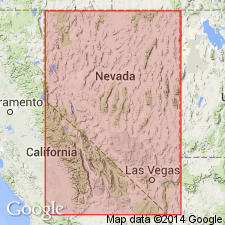
- Usage in publication:
-
- Augusta Mountain Formation*
- Modifications:
-
- Revised
- AAPG geologic province:
-
- Great Basin province
Summary:
Panther Canyon and Smelser Pass Members of the Augusta Mountain Formation are assigned to the stratigraphic position formerly inferred for the Congress Canyon Formation. Conodonts found in the Home Station Member of the August Mountain Formation indicate shallow subtidal condition of deposition. Abundant conodonts from the Smelser Pass Member indicate a nearshore normal marine environment.
Source: GNU records (USGS DDS-6; Menlo GNULEX).
For more information, please contact Nancy Stamm, Geologic Names Committee Secretary.
Asterisk (*) indicates published by U.S. Geological Survey authors.
"No current usage" (†) implies that a name has been abandoned or has fallen into disuse. Former usage and, if known, replacement name given in parentheses ( ).
Slash (/) indicates name conflicts with nomenclatural guidelines (CSN, 1933; ACSN, 1961, 1970; NACSN, 1983, 2005, 2021). May be explained within brackets ([ ]).

